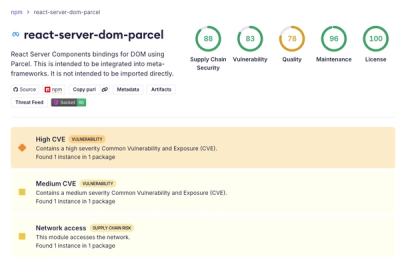
Security News
Deno 2.6 + Socket: Supply Chain Defense In Your CLI
Deno 2.6 introduces deno audit with a new --socket flag that plugs directly into Socket to bring supply chain security checks into the Deno CLI.
react-redux-modules
Advanced tools
React component modules that easily integrate with your Redux store.
These modules assume you have an understanding of how to use React and Redux.
Make sure your project has React and Redux installed, otherwise install those dependencies as well.
yarn add react-redux-modules
Or install all required dependencies with:
yarn add react react-dom redux react-redux react-redux-modules
You should have a Redux store set up in your React application. We will walk through the steps required to implement a component that uses the LoginForm component from react-redux-modules.
import React, { Component } from 'react';
import LoginForm from 'react-redux-modules/lib/components/LoginForm';
import { authenticate } from '../store/user/action';
class LoginPage extends Component {
render() {
return (
<h2>Login</h2>
<LoginForm
model="loginForm"
apiUrl={process.env.REACT_APP_API_URL}
loginSuccessAction={authenticate}
/>
);
}
}
export default LoginPage;
Make sure to set the apiUrl prop with the url for your API login endpoint where the form will issue a POST request.
Use a meaningful name for the model prop as it will be necessary to use in the creation of the reducer.
Now an action is needed that implements the authenticate logic, which will be dispatched after the Log In button is clicked and the API responds successfully. You can also set up a reducer that listens to the action type to save the data that comes back in the response in your Redux store.
export const authenticate = user => ({ type: ActionTypes.AUTHENTICATE, user });
Now set up a user reducer to update the data in your Redux store. In this example, it is assumed that the API responds with data about the user that just logged in.
const initialUserState = {
id: null,
isAuthenticated: false,
name: null,
};
export default (state = initialUserState, action) => {
switch (action.type) {
case 'AUTHENTICATE':
const { id, name } = action.user;
return { ...state, isAuthenticated: true, id, name };
default:
return state;
}
};
And finally, configure your Redux store with the user reducer and the react-redux-modules reducer used by the LoginForm. Notice the call to loginReducer uses the name of the model we used in the component.
import { combineReducers, createStore } from 'redux'
import { loginReducer } from 'react-redux-modules/lib/reducers/loginReducer';
import user from './user/reducer';
export default function configureStore(history) {
const root = combineReducers({
user,
...loginReducer('loginForm'),
});
const store = createStore(root);
return store;
}
FAQs
React Component Modules that integrate with your Redux store
We found that react-redux-modules demonstrated a not healthy version release cadence and project activity because the last version was released a year ago. It has 1 open source maintainer collaborating on the project.
Did you know?

Socket for GitHub automatically highlights issues in each pull request and monitors the health of all your open source dependencies. Discover the contents of your packages and block harmful activity before you install or update your dependencies.

Security News
Deno 2.6 introduces deno audit with a new --socket flag that plugs directly into Socket to bring supply chain security checks into the Deno CLI.

Security News
New DoS and source code exposure bugs in React Server Components and Next.js: what’s affected and how to update safely.

Security News
Socket CEO Feross Aboukhadijeh joins Software Engineering Daily to discuss modern software supply chain attacks and rising AI-driven security risks.